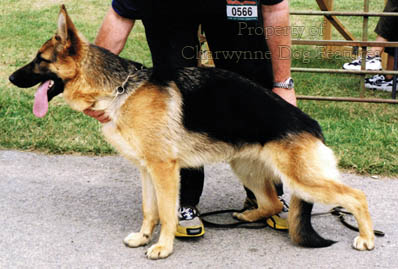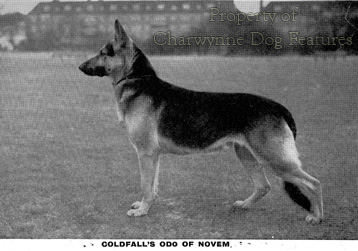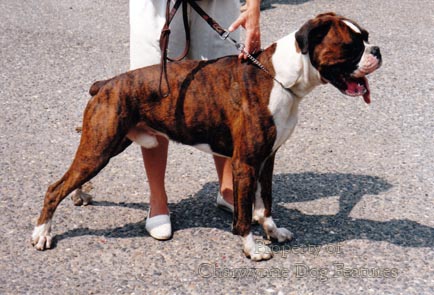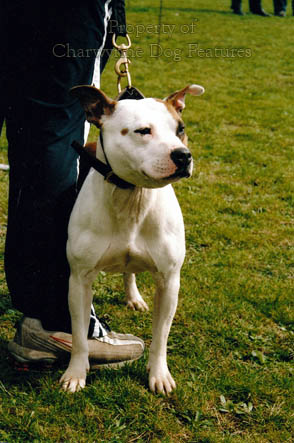370 Paying the Price of Popularity
PAYING THE PRICE OF POPULARITY
by David Hancock
 Going to Crufts this year? It is certainly the best publicized event for dogs in Britain, if not for British dogs. If you favour gundogs, it will please you to know that the Labrador and Golden Retrievers and the Cocker and English Springer spaniels still feature in the top ten most popular breeds registered with the Kennel Club. Less pleasing to learn is that at Battersea alone last year, 40 Cocker Spaniels and 30 Labradors had to be humanely destroyed because it was not possible to rehome them. Also less pleasing is the fact that in the gundog group, of the 33 breeds listed, less than half are British. In 1908, fifteen breeds were registered, all of them British.
Going to Crufts this year? It is certainly the best publicized event for dogs in Britain, if not for British dogs. If you favour gundogs, it will please you to know that the Labrador and Golden Retrievers and the Cocker and English Springer spaniels still feature in the top ten most popular breeds registered with the Kennel Club. Less pleasing to learn is that at Battersea alone last year, 40 Cocker Spaniels and 30 Labradors had to be humanely destroyed because it was not possible to rehome them. Also less pleasing is the fact that in the gundog group, of the 33 breeds listed, less than half are British. In 1908, fifteen breeds were registered, all of them British.
If you visit Crufts on the day on which Working and Pastoral breeds are being judged, you will become increasingly aware not just of the overwhelming number of breeds which originated outside the United Kingdom but how many of those have only fairly recently become imports. Checking the list of breeds in these groups recognised by the Kennel Club, my fears were confirmed: 52 breeds recognised, 41 originated abroad and only 11 here. How very different that could have been and how we have neglected our native working dogs.
But quite apart from the overwhelming numbers of foreign dogs in these groups at Crufts, it is remarkable how enormous the disparity is in the numbers of some breeds present. German breeds like the Rottweiler, the Dobermann and German shepherd dog dominate the entry. And if you look at the annual registrations of breeds with the Kennel Club in this group, this fact becomes even more striking. In the year 2000 three thousand Dobermanns, nearly 18,000 German shepherd dogs and well over 5,000 Rottweilers were registered. If you add to these breeds, 10,500 Boxers and nearly two thousand Great Danes, we would appear to be trying really hard to promote the dogs of Germany. If you asked me to recommend a guarding breed it would be our own Bullmastiff, yet in 2000 some 2,300 were registered - against 38,500 German dogs !
In any free society, quite rightly, people are free to choose the breed of dog that has appeal for them, however unwise or misguided such choices can turn out to be. But nowadays there are dangers in choosing a breed which is either bred in great numbers or suddenly becomes the desired breed of the trend-chasers. Every breed has its merits but the public are remarkably unwary of the risks attached to the highly popular, overbred, very numerous, overproduced breeds. The national newspapers have perhaps overpublicised the behavioural problems in some of these too popular breeds but all too often overlook the physical problems sadly associated with overproduction. Demand, regrettably, attracts the puppy-farmers and the less honourable breeders.
The most popular breeds registered annually with the Kennel Club over the last few years are led by those that, far too often, feature inherited defects, physical unsoundness and suspect temperament. The German shepherd dog is usually near the top of this popularity poll with over 17,000 new registrations each year. This is a fine breed when well bred; quick to mature, eager to please and responding well to training. But I would hesitate many times before owning one, not because of the all too often exaggerated stories of their behaviour or even through the congenital disease problems in the breed, but because I do not believe the contemporary fad for curvature of the spine and the hindquarters of a cat produces a physically sound dog.
This fad has only appeared in the last few decades; why should a breed, that when first introduced here at the start of the century had a level topline, suddenly need to feature a roach back and underslung back legs ? Why don't other breeds of dog display this strange anatomical feature if it is so desirable ? Look at the early photographs of the founding stock in the breed: Cito v. Bergerslust (1922 German Grand Champion Dog), Asta v. Kaltenweide (1922 German Grand Champion Bitch), Claus v. d. Furstenburg (1922 Austrian Grand Champion), Anni v. Alfenbosch of Comus (1922 Dutch Grand Champion Bitch), Astor v. d. Rathenau-Schlucht (1925 German Police Grand Champion) and then the Brittas, Saltburn or Southdown products of fifty or sixty years or so ago. Such dogs had a level topline and no hyper-angulation in their hindquarters; why the need for change and who has the right to inflict human whim on functional animals ? 
The German shepherd dog, the Labrador and the Golden Retriever each as breeds have worrying problems both in behaviour and genetic health. These three breeds provide the top three in the most numerous breeds as registered with the Kennel Club in recent years. In 2000 over 800 German shepherds ended up in Battersea Dogs' Home, 7.6% of the intake; 350 were destroyed. These breeds feature high up in the list of breeds that most often display suspect temperament.
Another highly popular breed, the Yorkshire terrier, is a victim of the public demand for miniature dogs, with deformed tear ducts, progessive loss of sight, slipping knee caps and collapsing hip joints being just some of the defects found in the breed. Another 7,000 are registered with the KC every year; there is no control over the soundness of their breeding. A plucky little breed and a valued companion, they are paying the penalty of popularity coupled to rampant human whim. When are we going to consider the well-being of such dogs ?
One day soon, the first question to be asked when choosing a breed of dog might be: how many of them are being bred? There is not exactly safety in numbers in dog-breeding! Perhaps one day, not soon enough, we might decide to respect dogs for what they are rather than what we want them to be or what we desire to copy. I heard recently of three Neapolitan Mastiffs, each weighing around ten stones, being kept in a first floor London flat. They were left alone all day whilst their owner was at work. The owner had been able to pay £2,500 for them but not keep them in a manner appropriate for the breed. 
I shudder when I see a breed used to advertise a product on commercial television. Featuring an Old English sheepdog in the well known paint advertisement led to literally hundreds of the breed ending up abandoned, once unthinking new owners realised what their coat and appetite required. I can quite understand the horror of responsible Dalmatian breed lovers over the Disney film featuring their breed. They are left to pick up and rehome the unwanted dogs once the temporary surge in demand has made its mark. The KC registers around 70,000 litters a year; they are bred without health checks and little regard for their temperament. The public demands pups of a breed ahead of pups that live a long healthy life as acceptable pets.
The Labrador may be the nation's most popular dog, but the number needing rehoming has risen dramatically. When the admirable Labrador Rescue Trust was launched in 1988, it rehomed just 10 Labradors. Now it is over 500 a year and still rising. One Labrador breeder alone registered 18 litters in one year. This breeder had been banned for falsifying hip score certificates. In another breed, a breeder registered 973 pups in ten years, 589 by the same stud dog. This sire had no health clearances. Why are the general public prepared to purchase a pup from a popular breed without knowing if it will go blind, is deaf, might develop epilepsy or bite the neighbours?
It is easy to understand the public becoming interested in an exotic breed or under-rating a native breed. That is a matter of personal choice. But for the public to purchase, often at a cost of between £500 and £1,000, a pup of a breed suddenly made popular without any knowledge of its parents' health, is very unwise. It is usually just a costly lesson for the purchaser; for the dog it can mean destruction. The numbers of Labradors, Staffordshire Bull Terriers, Boxers, Rottweilers, Bull Terriers and Weimaraners may have doubled in twenty years but at what cost to their owners and the breed? Dogs are subject creatures at our whim; we decide if they are bred and how they are bred.
Breeds are promoted at national events such as Crufts dog show and Discover Dogs each year. The dog is now a commercial product, offered to the consumer with a wide choice. Breeders aim to make money from their dogs and the KC has to make money from registrations to finance its social club. But any commercial product has to meet certain criteria, defective goods can be changed/replaced under the law. Defective dogs settle in to loving homes and are not so easily taken back to their sales outlet. They may die young, suffer constantly or end up in a dogs' home. But we live in times when the public is increasingly willing to complain about faulty goods.
If a breed becomes much in demand and is carelessly bred in order to keep up with demand, it is simply not good enough to expect the rescue organisations to face the unfortunate consequences. It is not right for the general public to have to suffer the early loss of a sickly expensive pet dog. There are a number of remedies for this sad situation. Firstly, the KC should refuse to register a dog unless its parents have had health checks. It is surely irresponsible, even reckless, to provide a pedigree certificate as a kind of kitemark if the goods are substandard. Secondly, every breeder should be obliged to take back stock not meeting health criteria under their control. Inheritable disabling diseases and bad temperament are under their control. But, thirdly, the buying public have to display more sense, greater responsibility, a lot more shrewdness. They should make the life of a bad breeder absolute hell, just as much as such a breeder makes the life of their unfortunate produce. The price of popularity shouldn't just be borne by the dogs!